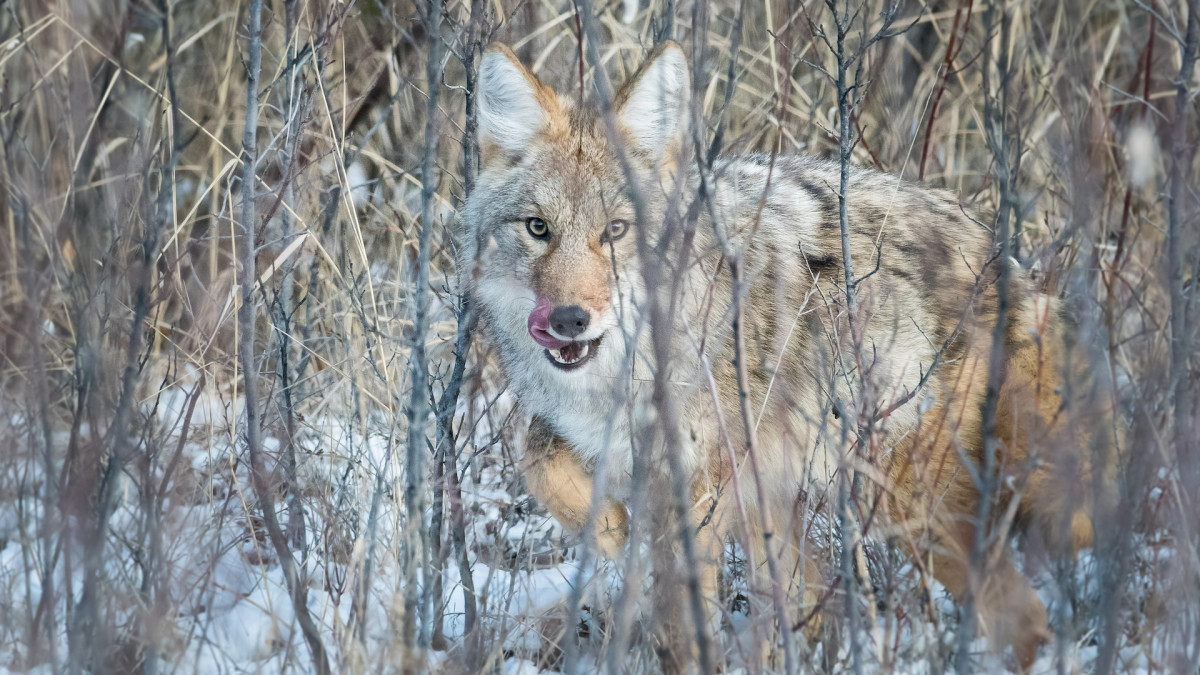
Coyotes rarely attack humans. However, when they do, biologists aren’t always sure what compels the usually timid canines to target a much larger, two-legged prey. Now, a new study published in the Journal of Applied Ecology offers at least one explanation.
Researchers tracked and analyzed coyote movement and behavior in Cape Breton Highlands National Park (CBHNP) in Nova Scotia and concluded that moose predation is likely a contributing factor to the park’s high rate of coyote attacks on humans.
“We have described a unique ecological system in which a generalist carnivore has expanded its ecological niche to specialize on a large prey species, with the unfortunate consequence of also expanding pathways to conflicts with people,” the authors write.
“Unfortunate” is an understatement. There has been only one documented case of a fatal coyote attack in the U.S. and Canada, and it occurred in 2009 in Cape Breton Park. A 19-year-old folk singer from Toronto was attacked and killed by two coyotes while hiking alone on a popular trail. She was found alive by other hikers but died from her injuries later that day.
Coyote attacks are rare nationwide, but Canis latrans is responsible for 31% of all documented attacks on people by a large carnivore species—the most of any such carnivore. And Cape Breton coyotes appear to be particularly aggressive. In recent years, the park has recorded 32 coyote–human incidents, including seven independent cases where coyotes bit and injured people.
In most environments, coyote attacks occur when they begin to see humans’ own food as a source of food. They lose their fear of people and take bolder steps to go after a slice of leftover pizza, for example.
But the situation in Cape Breton turns that story on its head. This 234,000-acre park is sparsely populated by humans, and GPS collar data indicates that the coyote packs have large home ranges. That suggests that the animals aren’t congregating around human settlements and eating dog food left out in the yard.
What’s more, when the researchers analyzed the stable isotopes in whisker samples alongside coyote scat, they found that the canines weren’t surviving on human food. Instead, they found something surprising: moose meat comprised the majority of their diet.
Mixing models showed that moose comprised an average of 52.5% of the diets of 28 of the 32 coyotes studied. A 2019 study of coyotes in the same area also found that moose comprised 57% of their diet with some seasonal frequencies in winter and spring exceeding 70%.
Generally, coyotes rarely eat moose. But researchers noted that prey abundance was low in the park, especially the hares and deer that typically comprise the majority of a coyote’s diet. So coyotes do what they do best–they adapted and began to prey on North America’s largest ungulate. Researchers assume that most moose consumption resulted from scavenging, but they also found evidence of direct predation.
“At least one carcass located during winter coyote tracking showed signs of predation, and on other occasions live, adult moose were observed with fresh wounds consistent with coyote bites, in addition to coyote tracks leading to the moose,” they write.
Coyotes likely target moose when they get stuck in high snowdrifts, which frequently form in the park.
What does this have to do with coyote attacks on humans? The study’s authors speculate that after emerging victorious from a fight with a moose, people didn’t seem all that scary to the coyotes. The park also does not allow coyote hunting, which could also contribute to their bold stance toward humans.
“If they were learning how to successfully hunt moose, then hunting a person is probably not all that difficult,” biologist Seth Newsome told the Wildlife Society.
The authors are careful to note that Cape Breton Park is a unique ecological situation. The park’s topography combined with limited hunting and a lack of usual prey species forced coyotes to target an animal that would not otherwise try to tackle. If you live in an area where coyotes and moose overlap, you shouldn’t live in fear of being jumped by a 40-pound wild dog.
But the researchers still encouraged wildlife managers and outdoor recreators to be on the lookout for where these unique circumstances collide, and maybe carry a can of bear spray even if coyotes are the biggest, meanest carnivore around.






